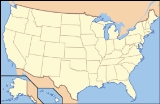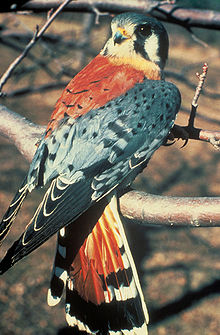
Lacreek National Wildlife Refuge
Encyclopedia
Lacreek National Wildlife Refuge is located in the U.S. state
of South Dakota
and includes 16,410 acres (66.4 km2). Early conservation work to protect the refuge was performed by the Civilian Conservation Corps
during the 1930s. A combination of wetlands, meadows and small stands of planted trees in the upland sections provide habitat for a wide variety of species. Much of the refuge has a series of low dikes that help to maintain some areas in a prolonged wetland state, increasing wildlife habitat, especially for migratory bird species. The refuge borders the Nebraska Sandhills country on the north and the sandhills provide water runoff well into the early summer. The refuge is managed by the U.S. Fish and Wildlife Service
 Since the late 1950s, 281 distinct species of birds have been sighted at the refuge. During the Spring and Fall migratory periods, as many as 29,000 ducks and 37,000 geese have been observed. Between 80 and 100 Trumpeter swan
Since the late 1950s, 281 distinct species of birds have been sighted at the refuge. During the Spring and Fall migratory periods, as many as 29,000 ducks and 37,000 geese have been observed. Between 80 and 100 Trumpeter swan
s spend the winter at the refuge, and Ring-necked pheasants, though an introduced species, are abundant. The endangered
Whooping crane
as well as the threatened
Bald eagle
are the endangered and threatened bird species that have been recorded in the district.
Red-tailed hawk
, Swainson's hawk
, Northern harrier, American kestrel
, Great horned owl
as well as less frequent sightings of Golden eagle
s have been documented as raptors known to frequent the district.
Various mammal
species also thrive here, including the Pronghorn
, White-tailed deer
, Mule deer
, coyote
, and badger
and are relatively common.
Fish species such as the Yellow perch
, Northern pike
and a variety of smaller non game fish species thrive in the abundant ponds and waterways, providing a major source of food for many of the migratory bird species. The refuge allows fishing
and hunting
in limited areas and in season.
near Sturgis, South Dakota
, Bear Butte NWR is also partly managed by the South Dakota Game Fish and Parks. It is located at 44°27′20"N 103°26′45"W
U.S. state
A U.S. state is any one of the 50 federated states of the United States of America that share sovereignty with the federal government. Because of this shared sovereignty, an American is a citizen both of the federal entity and of his or her state of domicile. Four states use the official title of...
of South Dakota
South Dakota
South Dakota is a state located in the Midwestern region of the United States. It is named after the Lakota and Dakota Sioux American Indian tribes. Once a part of Dakota Territory, South Dakota became a state on November 2, 1889. The state has an area of and an estimated population of just over...
and includes 16,410 acres (66.4 km2). Early conservation work to protect the refuge was performed by the Civilian Conservation Corps
Civilian Conservation Corps
The Civilian Conservation Corps was a public work relief program that operated from 1933 to 1942 in the United States for unemployed, unmarried men from relief families, ages 18–25. A part of the New Deal of President Franklin D...
during the 1930s. A combination of wetlands, meadows and small stands of planted trees in the upland sections provide habitat for a wide variety of species. Much of the refuge has a series of low dikes that help to maintain some areas in a prolonged wetland state, increasing wildlife habitat, especially for migratory bird species. The refuge borders the Nebraska Sandhills country on the north and the sandhills provide water runoff well into the early summer. The refuge is managed by the U.S. Fish and Wildlife Service

Trumpeter Swan
The Trumpeter Swan, Cygnus buccinator, is the largest native North American bird, if measured in terms of weight and length, and is the largest living waterfowl species on earth. It is the North American counterpart of the European Whooper Swan.-Description:Males typically measure from and weigh...
s spend the winter at the refuge, and Ring-necked pheasants, though an introduced species, are abundant. The endangered
Endangered species
An endangered species is a population of organisms which is at risk of becoming extinct because it is either few in numbers, or threatened by changing environmental or predation parameters...
Whooping crane
Whooping Crane
The whooping crane , the tallest North American bird, is an endangered crane species named for its whooping sound. Along with the Sandhill Crane, it is one of only two crane species found in North America. The whooping crane's lifespan is estimated to be 22 to 24 years in the wild...
as well as the threatened
Threatened species
Threatened species are any speciesg animals, plants, fungi, etc.) which are vulnerable to endangerment in the near future.The World Conservation Union is the foremost authority on threatened species, and treats threatened species not as a single category, but as a group of three categories,...
Bald eagle
Bald Eagle
The Bald Eagle is a bird of prey found in North America. It is the national bird and symbol of the United States of America. This sea eagle has two known sub-species and forms a species pair with the White-tailed Eagle...
are the endangered and threatened bird species that have been recorded in the district.
Red-tailed hawk
Red-tailed Hawk
The Red-tailed Hawk is a bird of prey, one of three species colloquially known in the United States as the "chickenhawk," though it rarely preys on standard sized chickens. It breeds throughout most of North America, from western Alaska and northern Canada to as far south as Panama and the West...
, Swainson's hawk
Swainson's Hawk
The Swainson's Hawk , is a large buteo hawk of the Falconiformes, sometimes separated in the Accipitriformes like its relatives. This species was named after William Swainson, a British naturalist...
, Northern harrier, American kestrel
American Kestrel
The American Kestrel , sometimes colloquially known as the Sparrow Hawk, is a small falcon, and the only kestrel found in the Americas. It is the most common falcon in North America, and is found in a wide variety of habitats. At long, it is also the smallest falcon in North America...
, Great horned owl
Great Horned Owl
The Great Horned Owl, , also known as the Tiger Owl, is a large owl native to the Americas. It is an adaptable bird with a vast range and is the most widely distributed true owl in the Americas.-Description:...
as well as less frequent sightings of Golden eagle
Golden Eagle
The Golden Eagle is one of the best known birds of prey in the Northern Hemisphere. Like all eagles, it belongs to the family Accipitridae. Once widespread across the Holarctic, it has disappeared from many of the more heavily populated areas...
s have been documented as raptors known to frequent the district.
Various mammal
Mammal
Mammals are members of a class of air-breathing vertebrate animals characterised by the possession of endothermy, hair, three middle ear bones, and mammary glands functional in mothers with young...
species also thrive here, including the Pronghorn
Pronghorn
The pronghorn is a species of artiodactyl mammal endemic to interior western and central North America. Though not an antelope, it is often known colloquially in North America as the prong buck, pronghorn antelope, or simply antelope, as it closely resembles the true antelopes of the Old World and...
, White-tailed deer
White-tailed Deer
The white-tailed deer , also known as the Virginia deer or simply as the whitetail, is a medium-sized deer native to the United States , Canada, Mexico, Central America, and South America as far south as Peru...
, Mule deer
Mule Deer
The mule deer is a deer indigenous to western North America. The Mule Deer gets its name from its large mule-like ears. There are believed to be several subspecies, including the black-tailed deer...
, coyote
Coyote
The coyote , also known as the American jackal or the prairie wolf, is a species of canine found throughout North and Central America, ranging from Panama in the south, north through Mexico, the United States and Canada...
, and badger
Badger
Badgers are short-legged omnivores in the weasel family, Mustelidae. There are nine species of badger, in three subfamilies : Melinae , Mellivorinae , and Taxideinae...
and are relatively common.
Fish species such as the Yellow perch
Yellow perch
The yellow perch is a species of perch found in the United States and Canada, where it is often referred to by the shortform perch. Yellow perch look similar to the European perch, but are paler and more yellowish, with less red in the fins. They have six to eight dark, vertical bars on their sides...
, Northern pike
Northern Pike
The northern pike , is a species of carnivorous fish of the genus Esox...
and a variety of smaller non game fish species thrive in the abundant ponds and waterways, providing a major source of food for many of the migratory bird species. The refuge allows fishing
Fishing
Fishing is the activity of trying to catch wild fish. Fish are normally caught in the wild. Techniques for catching fish include hand gathering, spearing, netting, angling and trapping....
and hunting
Hunting
Hunting is the practice of pursuing any living thing, usually wildlife, for food, recreation, or trade. In present-day use, the term refers to lawful hunting, as distinguished from poaching, which is the killing, trapping or capture of the hunted species contrary to applicable law...
in limited areas and in season.
Bear Butte National Wildlife Refuge
Bear Butte National Wildlife refuge is managed from Lacreek NWR and is now open to the public. Located in southwestern Meade CountyMeade County, South Dakota
As of the census of 2000, there were 24,253 people, 8,805 households, and 6,700 families residing in the county. The population density was 7 people per square mile . There were 10,149 housing units at an average density of 3 per square mile...
near Sturgis, South Dakota
Sturgis, South Dakota
Sturgis is a city in Meade County, South Dakota, United States. The population was 6,627 as of the 2010 census. It is the county seat of Meade County. Sturgis is famous for being the location of one of the largest annual motorcycle events in the world, which is held annually on the first full week...
, Bear Butte NWR is also partly managed by the South Dakota Game Fish and Parks. It is located at 44°27′20"N 103°26′45"W

